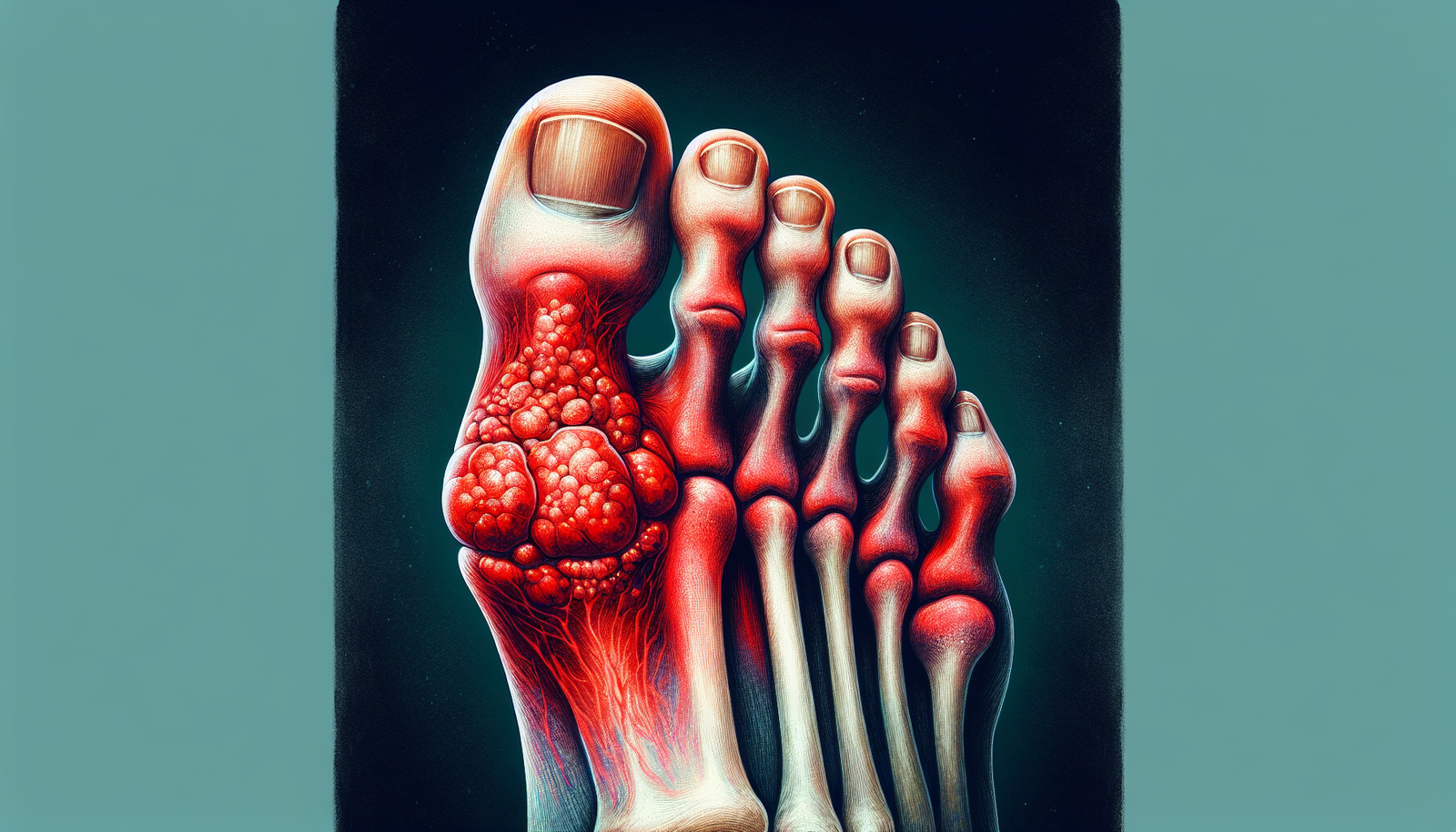Have you ever experienced sudden and intense pain in your joints, particularly in your big toe? If so, you may be familiar with the symptoms of gout. This article will uncover the various signs and indicators of gout, helping you gain a better understanding of this painful condition. From the throbbing discomfort to the redness and swelling, recognizing these symptoms can assist you in seeking appropriate medical attention and finding relief. Gout is a form of inflammatory arthritis that occurs when there is a buildup of uric acid in the body. This condition can cause sudden and intense pain, swelling, and redness in the joints. Gout primarily affects the joints in the feet, particularly the big toe, but it can also occur in other joints such as the ankles, knees, wrists, and elbows.
Gout Overview
Gout is a condition characterized by elevated levels of uric acid in the blood, leading to the formation of urate crystals in the joints. These crystals can trigger an inflammatory response, resulting in painful symptoms. It is important to understand the causes, risk factors, and prevalence of gout in order to effectively manage and prevent its occurrence.
Definition
Gout is defined as a type of arthritis that is caused by the deposition of urate crystals in the joints. These crystals form when there is an excessive buildup of uric acid in the blood, a condition known as hyperuricemia. The crystals can cause inflammation, leading to pain, redness, and swelling in the affected joints.
Causes
The primary cause of gout is an accumulation of uric acid in the blood. Uric acid is a waste product that is produced when the body breaks down purines, which are found in certain foods and beverages. If the body is unable to eliminate excess uric acid efficiently, it can lead to the development of gout. Additionally, certain medical conditions and medications can contribute to gout by hampering the excretion of uric acid.
Risk factors
Several risk factors increase the likelihood of developing gout. These include a family history of gout, obesity, high blood pressure, diabetes, kidney disease, and excessive alcohol consumption. Men are more prone to developing gout than women, and the risk tends to increase with age.
Prevalence
Gout affects approximately 4% of adults in the United States, making it a relatively common condition. The prevalence of gout has been on the rise in recent years, likely due to the increasing rates of obesity and lifestyle factors such as poor dietary choices and sedentary behavior.
Early Symptoms of Gout
Recognizing the early symptoms of gout is crucial for early diagnosis and prompt treatment. By being aware of these symptoms, you can take appropriate measures to manage and control the condition.
Joint pain
One of the earliest and most common symptoms of gout is joint pain. The pain is often sudden and severe, typically occurring in the affected joint during the nighttime. The pain can be excruciating and may limit your ability to move or even touch the affected joint.
Redness
Gout can cause redness in the affected joint, which is often accompanied by intense heat. The affected area may appear swollen and inflamed, with a distinct red or purplish hue.
Swelling
Swelling is another hallmark symptom of gout. The affected joint may become visibly swollen and feel tender to the touch. The swelling can be so severe that it causes the skin to stretch and become shiny.
Gout Attacks
Gout attacks, also known as flares or acute gouty arthritis, refer to episodes of intense pain and inflammation in the joints. These attacks can last anywhere from a few days to several weeks and can recur periodically if not treated appropriately.
Sudden and intense pain
During a gout attack, you may experience a sudden onset of excruciating pain in the affected joint. The pain is often described as a throbbing or pulsating sensation, and it can be debilitating.
Tenderness
Along with the pain, the affected joint may become extremely tender to the touch. Even the lightest pressure or movement can cause intense discomfort.
Limited range of motion
Gout attacks can significantly impact your mobility. The affected joint may become stiff and difficult to move, restricting your range of motion. This limitation can further contribute to pain and discomfort.
Characteristic Signs of Gout
In addition to the symptoms mentioned earlier, gout can present with specific characteristic signs that further aid in its diagnosis.
Tophi formation
Tophi are small, chalky lumps that can develop under the skin in advanced cases of gout. These lumps are composed of urate crystals and commonly appear on the fingers, toes, elbows, and ears. Tophi can be painless but may cause deformity over time if left untreated.
Joint stiffness
Gout can cause joint stiffness, particularly during and after a gout attack. This stiffness may persist even between attacks, making it challenging to move the affected joint freely.
Fever
In some cases, gout attacks can be accompanied by fever. This systemic symptom, along with the localized symptoms of gout, can indicate an active inflammatory response in the body.

Gout Complications
If left untreated or poorly managed, gout can lead to several complications that can significantly impact your quality of life. It is vital to address these complications to prevent long-term joint damage and other associated health issues.
Recurrent gout attacks
One of the primary complications of gout is the recurrence of gout attacks. If the underlying causes and triggers are not addressed, gout attacks can become more frequent and severe over time, leading to chronic pain and joint damage.
Joint damage
Repeated gout attacks can cause gradual damage to the affected joints. The accumulation of urate crystals and the resulting inflammation can lead to the erosion of cartilage and bone, resulting in joint deformities and a reduced range of motion.
Kidney stones
Uric acid is excreted by the kidneys, and high levels of uric acid can increase the risk of developing kidney stones. These stones can cause severe pain and may require medical intervention to remove.
Assessing Gout Symptoms
To diagnose gout accurately, healthcare professionals employ various assessment methods, including physical examination, laboratory tests, and imaging tests.
Physical examination
During a physical examination, your healthcare provider will assess the affected joint for signs of redness, swelling, tenderness, and limited range of motion. They may also look for the presence of tophi or other characteristic signs of gout.
Lab tests
Laboratory tests play a crucial role in diagnosing gout. A blood test can measure the levels of uric acid in your blood. However, it is important to note that elevated uric acid levels alone do not confirm a diagnosis of gout, as some individuals with higher levels may never develop the condition.
Imaging tests
Imaging tests, such as X-rays or ultrasounds, may be ordered to visualize the affected joint and assess for joint damage or the presence of tophi. These tests can provide valuable information to inform treatment decisions.

Distinguishing Gout from Other Conditions
Gout shares similarities with other conditions, particularly various forms of arthritis. Distinguishing gout from these conditions is crucial to provide appropriate treatment and management strategies.
Arthritis
Gout is a specific type of arthritis characterized by the accumulation of uric acid crystals in the joints. Unlike other forms of arthritis, gout typically affects one joint at a time and is often associated with sudden onset and intense pain.
Pseudogout
Pseudogout, also known as calcium pyrophosphate deposition disease, is another type of crystal-induced arthritis. It shares similarities with gout, but the crystals involved are calcium pyrophosphate rather than uric acid. Pseudogout can also cause sudden attacks of joint pain, swelling, and redness.
Cellulitis
Cellulitis is a bacterial skin infection that can cause redness, swelling, and pain in the affected area. It can sometimes be mistaken for gout, particularly in cases where the infection occurs near a joint. However, cellulitis is not associated with the formation of uric acid crystals.
Common Gout Locations
Gout can affect various joints in the body, with certain locations being more commonly affected than others.
Big toe
The metatarsophalangeal joint of the big toe is one of the most frequently affected joints in gout. The pain and swelling in this area can be excruciating and may make it difficult to walk or wear shoes.
Ankle
The ankle joint is another commonly affected location in gout. The swelling and redness in this area can cause significant discomfort and limit your ability to bear weight on the affected foot.
Knee
Gout can also affect the knee joint, leading to pain, swelling, and stiffness. This can make it challenging to perform everyday activities that require bending or flexing the knee.
Foot
Aside from the big toe, other joints in the foot, such as the midfoot or the joints at the base of the toes, can be affected by gout. The pain and swelling in these areas can interfere with walking and wearing regular footwear.
Wrist
Although less common than other locations, the wrist joint can be affected by gout. The pain and inflammation in this area can limit your ability to twist or move the wrist freely.
Elbow
Similar to the wrist, the elbow joint can also be involved in gout. The characteristic symptoms of gout, such as pain, redness, and swelling, can occur in the elbow, restricting your range of motion.
Factors That Trigger Gout Attacks
Certain factors can increase the risk of triggering gout attacks in susceptible individuals. Understanding these triggers can help you make informed decisions to prevent the onset of gout symptoms.
Dietary choices
Dietary choices play a significant role in the development and management of gout. Foods and beverages that are high in purines, such as red meat, shellfish, organ meats, and alcoholic beverages, can increase uric acid levels and trigger gout attacks. Limiting consumption of these items can help reduce the risk of gout exacerbations.
Alcohol consumption
Alcohol, particularly beer, can increase the production of uric acid and interfere with its excretion, making individuals more susceptible to gout attacks. Reducing alcohol consumption, especially beer and spirits, can help mitigate the risk.
Obesity
Excess weight can contribute to the development of gout by increasing the production of uric acid and impairing its elimination. Losing weight through a combination of a healthy diet and regular exercise can help reduce the risk of gout attacks.
Medications
Certain medications, such as diuretics used to treat high blood pressure, can interfere with the excretion of uric acid, leading to higher levels in the blood. If you have gout or are at risk, discuss your medications with your healthcare provider to determine if any adjustments are necessary.
Medical conditions
Certain medical conditions, such as kidney disease, high blood pressure, and diabetes, can increase the risk of developing gout. Managing these conditions carefully and following your healthcare provider's recommendations can help prevent gout attacks.
Stress
Stress can trigger gout attacks in susceptible individuals. Finding healthy ways to manage stress, such as engaging in relaxation techniques or physical activity, can help reduce the likelihood of experiencing gout symptoms during stressful periods.
Gout in Women
While gout is more commonly associated with men, women can also develop this condition. However, gout tends to present differently in women and may be influenced by hormonal factors.
Symptoms and characteristics
In women, gout often develops after menopause, when hormonal levels change. The symptoms and characteristics of gout in women are similar to those in men, including joint pain, redness, swelling, and limited mobility.
Hormonal influences
Gout in women can be influenced by hormonal fluctuations, particularly during menopause. The decrease in estrogen levels can affect uric acid metabolism and increase the risk of developing gout.
Specific risk factors
Certain risk factors, such as obesity, high blood pressure, and diuretic use, can further increase the risk of gout in women. Managing these risk factors through lifestyle modifications and appropriate medical interventions is crucial for preventing gout attacks.
In conclusion, understanding the symptoms, causes, and risk factors of gout is essential for early diagnosis and effective management. Recognizing the early signs of gout, such as joint pain, redness, and swelling, can help you seek medical attention promptly. By addressing the triggers and risk factors that contribute to gout, such as dietary choices, alcohol consumption, and obesity, you can reduce the frequency and severity of gout attacks. Remember, it's important to work closely with your healthcare provider to develop a personalized treatment plan that addresses your specific needs and helps you live a fulfilling and pain-free life.



